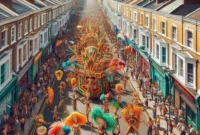
Unmasking the Shadows Behind the Fiery Celebrations
Up Helly Aa, the spectacular Viking fire festival held in Shetland, Scotland, is a dazzling display of tradition, community spirit, and historical pageantry. Every January, the town of Lerwick is illuminated by torch-lit processions, stunning costumes, and the dramatic burning of a Viking longship. However, beneath the festival’s fiery allure lies a darker narrative that has stirred controversy and prompted calls for change.
Cultural Appropriation or Preservation?
One of the most contentious issues surrounding Up Helly Aa is the debate over cultural appropriation versus cultural preservation. Critics argue that the festival, with its Viking-themed costumes and rituals, is a form of cultural appropriation. They contend that the celebration, initiated in the late 19th century, romanticizes a Viking heritage that is not authentically Shetlandic but rather a constructed identity imposed by Victorian-era romanticism.
On the other hand, defenders of the festival assert that Up Helly Aa is a vital part of Shetland’s cultural heritage. They argue that the event has evolved into a unique expression of local identity and community pride. Yet, the line between celebration and appropriation remains blurred, raising questions about the festival’s authenticity and respect for true historical traditions.
Gender Inequality: A Burning Issue
Another major criticism of Up Helly Aa is its long-standing exclusion of women from key roles. Traditionally, the festival’s organizing committee, known as the Jarl Squad, and the guizers (costumed participants) are exclusively male. This gender disparity has sparked significant backlash, with local and international voices calling for greater inclusivity.
In recent years, some progress has been made, with a few Up Helly Aa events allowing women to participate more fully. However, the main festival in Lerwick continues to uphold its male-only tradition, fueling ongoing debates about gender equality and the relevance of such exclusionary practices in modern society.
Environmental Concerns: The Flames of Controversy
The environmental impact of Up Helly Aa has also come under scrutiny. The festival’s signature event—the burning of a Viking longship—raises concerns about air pollution and environmental sustainability. Critics argue that the massive bonfire contributes to carbon emissions and waste, which are increasingly problematic in an era of heightened environmental awareness.
While organizers have made efforts to minimize the festival’s environmental footprint, such as using sustainable materials for the longship, the symbolic act of setting fire to a large structure remains contentious. As climate change becomes an ever-pressing global issue, the environmental implications of traditional festivals like Up Helly Aa are being reexamined.
The Cost of Tradition: Economic and Social Strains
The economic and social impact of Up Helly Aa on the local community is another aspect that warrants examination. Hosting such a large-scale event involves substantial financial costs, often funded by local businesses and public funds. Some residents argue that the money could be better spent on pressing community needs, such as healthcare, education, and infrastructure.
Furthermore, the influx of tourists drawn to the festival places a strain on local resources and services. While tourism provides an economic boost, it also disrupts daily life and can lead to tensions between locals and visitors. Balancing the benefits and drawbacks of tourism is a delicate task, and Up Helly Aa is no exception.
Moving Forward: Can Up Helly Aa Adapt?
- As Up Helly Aa continues to face criticism on multiple fronts, the question arises: can this beloved festival adapt to modern sensibilities without losing its essence? Advocates for change believe that embracing inclusivity, environmental responsibility, and cultural sensitivity is crucial for the festival’s future.
- Potential reforms could include greater involvement of women in all aspects of the festival, more environmentally friendly practices, and a reassessment of the festival’s historical narrative to ensure it honors Shetland’s true heritage. Such changes would not only address current criticisms but also help Up Helly Aa resonate with a broader audience.
Conclusion: A Festival at a Crossroads
Up Helly Aa stands at a crossroads, caught between tradition and transformation. The festival’s enduring appeal lies in its vibrant celebration of community and history, yet it must also navigate the challenges of cultural appropriation, gender inequality, environmental impact, and economic strain. By addressing these issues head-on, Up Helly Aa has the potential to evolve into a more inclusive and sustainable event, ensuring that its flames burn brightly for generations to come.
Read more: Controversy of Spain’s Running of the Bulls




2 comments